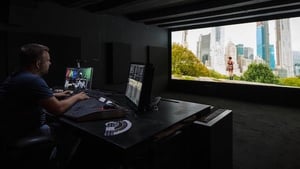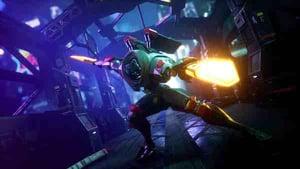
How Luma Pictures automates their workflows with ftrack APIs

Luma Pictures is a visual effects studio with facilities in Los Angeles, Melbourne, and Vancouver. Founded in 2002, the company is best known for its creatures, environments, and effects.
Its 100+ feature-film references include Elvis, Spider-Man: No Way Home, Black Panther, Pirates of the Caribbean: At World’s End, Guardians of the Galaxy; as well as Academy Award-winning films like Once Upon a Time in Hollywood, No Country for Old Men, Jojo Rabbit, and True Grit.
Michael Perdew joined Luma Pictures in 2009 and has since played an integral role in managing all aspects of the VFX production process, ensuring the seamless integration of technology, people, and processes. Michael's keen eye for detail and passion for innovation have helped him lead the VFX team to new heights of efficiency and creativity. He works closely with the Development and Systems team to stay ahead of the curve in automation, big data, and AI-driven technologies.
Michael was the one who originally decided to switch to ftrack for project tracking. He shepherded it through the years by integrating it closer and closer to Luma’s VFX pipeline until it became the core of all Luma’s production workflow automations.
Listen to Michael talk about his world at Luma with ftrack.
The coordinator's journey with ftrack, from task tracking to communication management and meeting scheduling
Project tracking is key to all types of production studios, whether they are post-production, VFX, animation studios, video, marketing, or beyond. While small to medium studios may fully lean on project tracking suites such as Backlight's ftrack Studio with its rich feature set, larger studios will look at integrating project tracking tools with their existing pipeline systems and creating custom workflows optimized for their complex pipeline environment.
This was the case for Luma Studios. Michael was the creator and architect of “LumaCoord Tools”, their custom pipeline automation engine for project planning and tracking, communication between producers, supervisors, coordinators, and artists, automatic meeting scheduling, and rendering preview automation.
As Michael explains, “our intent when developing LumaCoord Tools was to basically remove all coordinators' repetitive and boring tasks and allow them to focus on more rewarding ones and manage larger teams”.
And at the core of LumaCoord Tools are ftrack APIs.

How ftrack helped Luma optimize their communication processes between artists and coordinators with interactive notifications
The first task for LumaCoord Tools was to simplify the communication process between artists, coordinators, supervisors, and producers. At that time, artists were spread over three different sites, making the work of coordinators quite painful.
Before introducing ftrack, Michael had already built the first basic version of LumaCoord. It pinged artists and asked them to give a thumbs up or a thumbs down, based on how they felt about their workload that day. “If they gave a thumbs down, I’d talk to them. It was an easy way for me to check in. However, it didn't figure everything out. We took that theory and bolstered it a lot using ftrack, and we've developed something similar to what I would call interactive notifications.”
If a coordinator or an artist gets notes from the client or has something on his schedule for that day, an automated Mattermost Bot called "ProdBot" will message him with little prompts that he can give it back. Those prompts feed back into ftrack.
Perdew continues, “We've been using this in production for six to eight months, and it's been extremely successful. It's naturally part of their communication channel and allows artists not to be harassed by a coordinator. The people who love it the most are the artists because they just get a notification, click some things, write some notes, and then ftrack updates those notes into the production plan automatically. It makes artists feel like they’re not being micromanaged because they just get a regular check-in, and then that's all logged.
Producers and supervisors love it because they can crowdsource all this information back into ftrack in a way that I think is unique. Producers and coordinators have their view, they have my notes, and they have everything that they need to just go through and action whatever they need to.
Although it seems like a very obvious idea, I haven't seen any other company do this. Every other company has done it through coordinators who go, talk, and then update a field in the database.
The combination of LumaCoord Tools and ftrack is such a direct line to the artists.”

ftrack for automating team communication setup and management
Michael also added automated team communication setup and management to LumaCoord Tools. The goal was to adjust communication channels and processes every time a team member joined or left the project. “We have team members in ftrack, and if you add a new team member like a VFX supervisor, that suddenly drives them to be on a specific contact sheet that can be exported. It adds them to Mattermost channels (our internal messaging app), and automatically creates channels that can get these automatic messages.
Before, if I added a coordinator, I needed to update the email alias and all these other things. Right now, I can just change the coordinator; it automatically updates all my email aliases, changes them on what channels they go into, and what private channels by default. When people are assigned, it brings them into the right form of communication. So I'm using ftrack to organize all communication channels.”
ftrack for automating meeting management dailies reviews
Michael is already working on the next step, which is automatically setting up the attendee lists for each daily review based on the feedback collected by LumaCoord.
Michael explains, “Right now, LumaCoord does three things:
- When you have something due that week, it follows up with you and asks you if are on track or off track. If you're off track, you'd write notes.
- When something's exported for you, you may not be ready to grab it yet. So that's called the handoff system for us, but it allows them to confirm receipt or give kickbacks.
- And then when client notes come in, it gets them to say, “Hey, am I all clear or do I need clarification?” because sometimes they just need to talk to a supervisor, and sometimes you don't.
So the next evolution of that is saying things like “Okay, if you're not all clear, you need to talk to a supervisor”. It goes through ftrack and then adds you to the proper team's kickoff review and Google calendar.
We're making LumaCoord tie into all tools in our communication channel. Anything that production wants to control goes through ftrack, and then everything else is automated.
So if I want to change the attendees to a daily, if I need to swap a supervisor, if I need to split a sequence out, if a show doubles and I need to add another comp supervisor or something, I just manage that in ftrack and then have what I'm calling LumaCoord to do all the other things for me.”

ftrack at the core of VFX pipeline automation processes
Besides automating coordinators' tasks, Michael uses ftrack to run numerous pipeline automations that make the studio more efficient. This allows Luma Pictures to implement mass production tools that could work more at a sequence level or a scalable level, orchestrating their pipeline tools such as Katana, Houdini, and others.
Michael continues: ftrack was part of a bigger theme of our pipeline to allow essentially one artist to do up to 150 shots themselves. So the way we thought about it wasn't really managing bigger teams, but how much more work we can get out of a single artist or a few artists. So we could do things using ftrack’s powerful capabilities for organizing and tagging and making relationships and using links. And because you could make custom attributes in ftrack, we hit the apex of it. We tested what we'll call the scalable pipeline.

We did a lot of work for Marvel, and a scene with Molten Man in Spider-Man: Far From Home, which is this lava monster who's actually a hologram. And what was unique there was that you have this monster that's animated, but he has to be run through an effects simulation setup because he's made of lava. You'd have lava drips that would come off; they'd hit the ground, and they'd burn off on the ground. And you'd have fire and smoke. So this very complex effects simulation setup was driven solely by animation but had to be previewed through really fast.

And what we did on ftrack is we built a Molten Man-specific dashboard that actually had all the power attributes. We had our effects lead go in and write Molten Man's drip viscosity, Molten Man's flame height, etc. If he was at a certain distance from the camera, you might want the flames not to be as high or less high because he had little bits of fire on him. You could toggle on and off other attributes. And in ftrack, you would just go in and right-click the animation version and say I've updated the ftrack settings; now let me go right-click and relaunch this auto render or this auto simulation.
And then, because we had already built the tools before, you would write the simulations, and it would just publish you back a slap comp of a contact sheet of these effects elements. And if you thought they were good, you could just right-click the slap comp and then render that, and then put that through the actual comp. And then that would be the thing that the compositor would base off.
That was Luma's AACTA award from the Australian Academy. That was award-winning work, a very high point of both automation and scalability, and all the things came into play – thanks in part to ftrack.
Thanks to this pipeline automation enabled by ftrack, Luma was able to produce high-end VFX comparable to much larger VFX studios but at a boutique size.

ftrack’s impact on Luma Pictures business
In conclusion, LumaCoord is a great example of how developing tools rooted in ftrack can be simple but provide a big efficiency gain for the studio. Small investments in pipeline tools pay off significantly.
Pipeline automation tools are assistants that help artists and production remove repetitive tasks and allow them to focus on the fun challenges. This is why both supervisors, coordinators, and artists love LumaCoord Tools so much: It makes their work more rewarding!
As the VFX industry evolves each year, the tools and processes employed by studios like Luma Pictures need to keep up. The integration of ftrack APIs in Luma Pictures workflows and VFX pipeline is a testament to the studio’s commitment to efficiency and an example of how it stays ahead of the curve in creative media tech.
With ftrack in its arsenal, Luma Pictures can focus on what it does best – creating content that captivates minds – while enjoying a streamlined, efficient, and enjoyable workflow.
Luma Pictures’s journey with ftrack is a glowing example of the power project management tools can have in the creative industry. By embracing innovation and fostering a culture of continuous improvement, the Luma Pictures team has positioned themselves as pioneers in the VFX industry landscape. Wherever Luma heads next, ftrack will be there to keep teams connected and productions on track.
Unlock your studio’s potential
Start your free ftrack trial today and experience the transformative power of streamlined project management and collaboration.
More customer success stories







